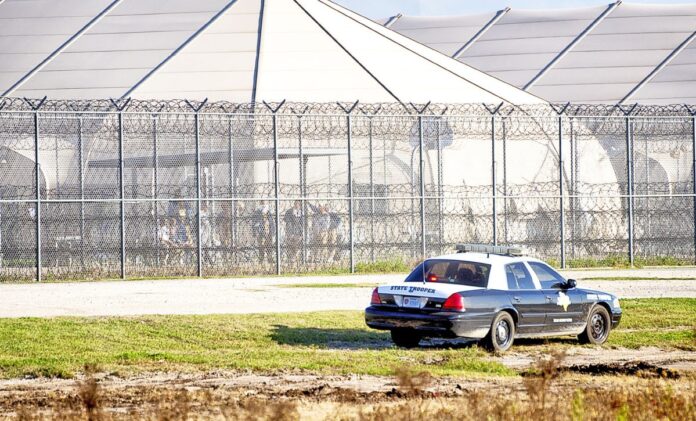RAYMONDVILLE — The county’s sale of the former “tent-city” prison might be a windfall for the city and school district.
But it depends on the appraised taxable value of the 53-acre site.
“I’m guessing it’s going to be a good chunk of change,” Mayor Gilbert Gonzales said yesterday.
Willacy County commissioners Tuesday entered into an agreement to sell the property to Management and Training Corp., the operator of the facility since it opened in 2006.
Now, the property will be placed on the tax rolls, generating $1.5 million to $2 million in property tax revenue in the area while creating about 250 jobs, County Judge Aurelio Guerra said.
But Guerra declined to disclose the purchase price until the deal closes later this week.
The county sold the property after bond holders demanded payment of its $68 million debt.
If it is appraised at $68 million, the property would generate tax revenue equal to about one-third of Raymondville’s current tax base, City Manager Eleazar Garcia said.
Based on the city’s tax rate of 75 cents per $100 valuation, Garcia said, that would add about $500,000 to the city’s tax total on its total valuation of $166 million.
But the property never has been appraised because, being county-owned, it has been tax-exempt, said Agustin Lopez, chief appraiser of the Willacy County Appraisal District.
So Lopez said he and a contracted company are preparing to begin an appraisal.
“We’re going to have a team come and appraise it,” Lopez said. “We’re going to make a full inspection of the prison. We don’t know the condition it’s in.”
But Lopez said the facility would have to become operational before he could assess its full taxable value.
As it stands, the property is not worth $68 million, Lopez said.
“I’m not going to say I’m going to put it at $68 million,” Lopez said. “Right now, it’s not worth $68 million. No one in their right mind would think it’s worth $68 million. It’s like an abandoned piece of property.”
Now, the facility basically consists of two high razor-wire fences surrounding a 1,000-bed concrete housing unit.
MTC plans to remove 10 tent-like Kevlar domes damaged in the February 2015 riot that led to the facility’s closure.
“But at the time it is operational, it might be $68 million,” Lopez said. “The income it supports will be worth that.”
MTC has not determined when the facility will open, Issa Arnita, the company’s spokesman, said yesterday.
“Once this deal is finalized, our next step will be to find a customer who needs space for those in their custody,” Arnita said in a statement. “We will also begin removing the Kevlar housing units and making repairs to the hard structure already in place.”
Prospects include U.S. Immigration and Customs Enforcement, which has expressed interest in the facility, officials have said.
Under ICE, the facility would become a detention center holding undocumented immigrants.
President Trump’s push to deport undocumented immigrants convicted of crimes helped lead to the deal, Guerra has said.
An ICE contract would pay wages similar to those of the former Willacy County Correctional Center, which held inmates for the Federal Bureau of Prisons, Sergio Molina, the company’s vice president for business development and administration, said Tuesday.
The prison paid some of the area’s best wages, Molina said.
Guerra is counting on the deal to help pull the county out of hard times.
The property, he said, is expected to generate $350,000 to $450,000 for the county, where the tax rate stands at 63 cents per $100 valuation.
As part of the deal, the agreement also will pay the county for each inmate held in the facility, Guerra said.
But he declined to disclose details until the deal closes.
In February 2015, the closure of the 3,000-bed prison, which paid the county for every inmate it housed, led to 400 employee layoffs, slashing a third of the county’s $8.1 million general fund budget.
“We recognize that not having the facility has put a tremendous financial strain on the county and we look forward to bringing back jobs, strengthening the local economy and working cooperatively with the county,” Arnita said.
As part of the agreement, Arnita said, the county agreed to dismiss a lawsuit against MTC.
Last December, the county filed a lawsuit against MTC, arguing its “abysmal mismanagement” led to the inmate uprising that destroyed much of the prison largely made up of tent-like domes in February 2015, plunging the county into financial crisis.
The lawsuit argued overcrowding and plumbing problems created “deplorable” inmate living conditions, raising tensions and leading inmates to destroy much of the 3,000-bed prison.
MTC denied the allegations, arguing it conducted “frequent comprehensive audits to make sure the facility was safe and clean and that it met all federal BOP standards.”




